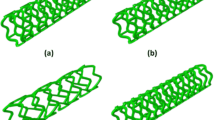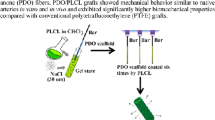Abstract
A bioresorbable, expandable poly(L-lactic acid) stent has been designed, based on a linear, continuous coil array principle, by which multiple furled lobes convert to a single lobe upon balloon expansion, without heating. Stent strength and compliance are sufficient to permit deployment by a conventional balloon angioplasty catheter. Several multiple lobe configurations were investigated, with expansion ratios ranging from 1.4 to 1.9 and expanded diameters ranging from 2.3 to 4.7 mm. Compression resistance of the expanded stent is dependent on fiber coil density and fiber ply. A range sufficient for endovascular service was obtained, with less than 4% elastic recoil in six day saline incubation studies. Surface plasma treatment with di(ethylene glycol) vinyl ether significantly reduced platelet adhesion in a 1 h porcine arteriovenous shunt model. Patency was maintained in one week implant studies in the porcine common femoral artery. However, a strong inflammatory response, and significant reduction of the vascular lumen were observed following two weeks implantation. The design principles and fabrication techniques for this bioresorbable stent are sufficiently versatile that a broad range of applications can be addressed. Much work remains to be done, including long-term evaluation of the inflammatory response, and of polymer degradation. The results of this study demonstrate the feasibility of expandable biodegradable stent design and deployment by conventional means. © 2003 Biomedical Engineering Society.
PAC2003: 8768+z, 8719Uv
Similar content being viewed by others
References
Agrawal, C. M., and H. G. Clark. Deformation characteristics of a bioabsorbable intravascular stent. Invest. Radiol.27:1020–1024, 1992.
Barstad, R. M., U. Orvim, M. J. Hamers, G. E. Tjonnfjord, F. R. Brosstad, and K. S. Sakariassen. Reduced effect of aspirin on thrombus formation at high shear and disturbed laminar blood flow. Thromb. Haemostasis75:827–832, 1996.
Blindt, R., K. M. Hoffmeister, H. Bienert, H. Pfannschmitt, G. Bartsch, H. Thissen, D. Klee, and J. Von Dahl. Development of a new biodegradable intravascular polymer stent with simultaneous incorporation of bioactive substances. Int. J. Artif. Organs22:843–853, 1999.
Clagett, G. P., and R. C. Eberhart. Artificial devices in clinical practice. Hemostasis and Thrombosis: Basic Principles and Clinical Practice, 3rd ed., edited by R. W. Colman, J. Hirsh, V. J. Marder, and E. W. Salzman. Philadelphia, PA: Lippincott, 1994, Chap. 77, pp. 1486–1505.
De Scheerder, I. K., K. L. Wilczek, E. V. Verbeken, J. Vandorpe, P. N. Lan, E. Schacht, J. Piessens, and H. De Geest. Biocompatibility of biodegradable and nonbiodegradable polymer-coated stents implanted in porcine peripheral arteries. Cardiovasc. Intervent. Radiol.18:227–232, 1995.
Dirschinger, J., A. Kastrati, and F. J. Neumann. Influence of balloon pressure during stent placement in native coronary arteries on early and late angiographic and clinical outcome: A randomized evaluation of high-pressure inflation. Circulation100:918–923, 1999.
Dollar, M. L., M. K. Sly, R. G. Credi, A. Constantinescu, C. C. Tsai CC, P. V. Kulkarni, G. P. Clagett, and R. C. Eberhart. Noninvasive quantification of platelet accumulation and release on indwelling venous catheters. ASAIO J.39:M268–M272, 1993.
Eberhart, R. C., S-H. Su, K. T. Nguyen, M. Zilberman, L. Tang, K. D. Nelson, and P. Frenkel. Bioresorbable polymeric stents: Current status and future prospects. (in press).
Farb, A., G. Sangiorgi, A. J. Carter, V. M. Walley, W. D. Edwards, R. S. Schwartz, and R. Virmani. Pathology of acute and chronic coronary stenting in humans. Circulation99:44–52, 1999.
Grizzi, I., H. Garreau, S. Li, and M. Vert. Hydrolytic degradation of devices based on poly(DL-lactic acid size dependence). Biomaterials16:305–311, 1995.
Houdijk, W. P., K. S. Sakariassen, P. F. Nievelstein, and J. J. Sixma. Role of factor VIII-von Willebrand factor and fibronectin in the interaction of platelets in flowing blood with monomeric and fibrillar human collagen types I and III. J. Clin. Invest.75:531–540, 1985.
Karino, T., H. L. Goldsmith, M. Motomiya, S. Mabuchi, and Y. Sohara. Flow patterns in vessels of simple and complex geometries. Ann. N.Y. Acad. Sci.516:422–441, 1987.
Kinlough-Rathbone, R. L., and D. W. Perry. Prolonged expression of procoagulant activity of human platelets degranulated by thrombin. Thromb. Haemostasis74:958–961, 1995.
Labinaz, M., J. P. Zidar, R. S. Stack, and H. R. Phillips. Biodegradable stents: The future of interventional cardiology?J. Intervent. Cardiol.8:395–405, 1995.
Li, J., M. K. Sly, R. Chao, A. Constantinescu, P. V. Kulkarni, F. H. Wians, Jr., M. E. Jessen, and R. C. Eberhart. Transient adhesion of platelets in pump-oxygenator circuits: Influence of SMA and nitric oxide treatments. J. Biomater. Sci., Polym. Ed.10:235–246, 1999.
Morice, M., P. W. Serruys, J. E. Sousa, J. Fajadet, E. Ban Hayashi, M. Perin, A. Colombo, G. Schuler, P. Barragan, G. Guagliumi, F. Molnar, and R. Falotico (RAVEL Study Group). A randomized comparison of a sirolimus-eluting stent with a standard stent for coronary revascularization. N. Engl. J. Med.346:1773–1780, 2002.
Morton, W. A., and R. D. Cumming. A technique for the elucidation of Virchow's triad. In: The Behavior of Blood and its Components at Interfaces. L. Vroman and E. F. Leonard, Eds. Ann. N.Y. Acad. Sci.283:477–493, 1977.
Nojiri, C., T. Okano, H. Koyanagi, S. Nakahama, K. D. Park, and S. W. Kim. protein adsorption on polymers: Visualization of adsorbed proteins on vascular implants in dogs. J. Biomater. Sci., Polym. Ed.4:75–88, 1992.
Park, K., F. W. Mao, and H. Park. Morphological characterization of surface-induced platelet activation. Biomaterials11:24–31, 1990.
Rechavia, E., M. C. Fishbein, and T. DeFrance. Temporary arterial stenting: Comparison to permanent stenting and conventional balloon injury in a rabbit carotid artery model. Cathet. Cardiovasc. Diagn.41:85–92, 1997.
Revak, S. D., C. G. Cochrane, B. N. Bouma, and J. H. Griffin. Surface and fluid phase activities of two forms of activated Hageman factor produced during contact activation of plasma. J. Exp. Med.147:719–729, 1978.
Richter, G. M., J. C. Palmaz, G. Noeldge, and F. Tio. Relationship between blood flow, thrombus, and neointima in stents. J. Vasc. Interv Radiol.10:598–604, 1999.
Rieu, R., P. Barragan, C. Masson, J. Fuseri, V. Garitey, M. Silvestri, P. Roquebert, and J. Sainsous. Radial force of coronary stents: A comparative analysis. Catheterization Cardiovasc Interv.46:380–391, 1999.
Talja, M., T. Valimaa, T. Tammela, A. Petas, and P. Tormala. Bioabsorbable and biodegradable stents in urology. J. Urol. (Baltimore)11:391–397, 1997.
Tamai, H., K. Igaki, E. Kyo, K. Kosuga, A. Kawashima, S. Matsui, H. Komori, T. Tsuji, S. Motohara, and H. Uehata. Initial and 6–month results of biodegradable poly-l-lactic acid coronary stents in humans. Circulation102:399–404, 2000.
Thakur, M. L., L. Walsh, H. L. Malech, and A. Gottschalk. Indium-111–labeled human platelets: Improved method, efficacy, and evaluation. J. Nucl. Med.22:381–385, 1981.
van Beusekom, H. M., D. M. Whelan, S. H. Hofma, S. C. Krabbendam, V. W. van Hinsbergh, P. D. Verdouw, and W. J. van der Giessen. Long-term endothelial dysfunction is more pronounced after stenting than after balloon angioplasty in porcine coronary arteries. J. Am. Coll. Cardiol.32:1109–1117, 1998.
Yamawaki, T., H. Shimokawa, T. Kozai, K. Miyata, T. Higo, E. Tanaka, K. Egashira, T. Shiraishi, H. Tamai, K. Igaki, and A. Takeshita. Intramural delivery of a specific tyrosine kinase inhibitor with biodegradable stent suppresses the restenotic changes of the coronary artery in pigs. J. Am. Coll. Cardiol.32:780–786, 1998.
Ye, Y. W., C. Landau, J. E. Willard, G. Rajasubramanian, A. Moskowitz, S. Aziz, R. S. Meidell, and R. C. Eberhart. Bioresorbable microporous stents deliver recombinant adenovirus gene transfer vectors to the arterial wall. Ann. Biomed. Eng.26:398–408, 1998.
Yuliang, J., H. Wu, R. B. Timmons, J. S. Jen, and F. E. Molock. Nonfouling surface produced by gas phase pulsed plasma polymerization of ultra-low-molecular-weight ethylene oxide containing monomer. Colloids Surf., B18:235–248, 2000.
Author information
Authors and Affiliations
Rights and permissions
About this article
Cite this article
Su, SH., Chao, R.Y.N., Landau, C.L. et al. Expandable Bioresorbable Endovascular Stent. I. Fabrication and Properties. Annals of Biomedical Engineering 31, 667–677 (2003). https://doi.org/10.1114/1.1575756
Issue Date:
DOI: https://doi.org/10.1114/1.1575756




